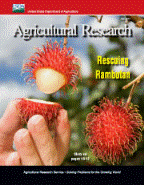United States Department of Agriculture: Agricultural Research Service, Lincoln, Nebraska

Agricultural Research Magazine
Date of this Version
2-2013
Document Type
Article
Citation
Agricultural Research February 2013.
Abstract
Agricultural Research Service scientists at the Agroecosystems Management Research Unit in Lincoln, Nebraska, have been conducting some very thorough investigations on the microbes that dwell in cattle manure—what they are, where they thrive, where they struggle, and where they may end up. “When we look at potential pathogens that can cause foodborne illness, we need to look at the whole bacterial ecosystem,” says ARS microbiologist Lisa Durso. “For instance, some people used to think all cattle have the same bacteria in their gastrointestinal [GI] tracts. But we’ve found some big differences; so if we say, ‘Oh, it’s just manure,’ we could miss important factors in pathogen control.”
That’s why Durso headed up a study that provided the first-ever “gold standard” accounting of the fecal bacterial types associated with beef cattle.
The researcher used pyrosequencing, a relatively new method of rapidly analyzing bacterial DNA markers, to classify the bacteria into different taxonomic groups. “People hadn’t looked at doing this type of bacterial census before, because some bacteria could be cultured, but other types didn’t grow well,” says Durso, who conducted this investigation while she was working at the ARS U.S. Meat Animal Research Center in Clay Center, Nebraska. “Pyrosequencing let us give every bacterium a name tag ID.”
Using fecal samples from six beef cattle, Durso identified a core set of bovine GI bacterial groups common to both beef and dairy cattle. But she also determined that Prevotella was the most common bacterial genus in the cattle she studied—occurring in 24 percent of the total number of DNA sequences she analyzed.
Another published study had identified Prevotella in only 5.5 percent of the bacterial genes sequenced from 20 dairy cattle. And while another survey had identified Clostridium in 19 percent of the bacterial DNA sequenced from dairy cattle, Durso detected the genus in only 1.5 percent of the DNA sequences in her study.
Durso observed bacteria in the beef cattle that had not been reported in dairy cows. She also identified a diverse assortment of bacteria from the six individual beef cows, even though all six animals consumed the same diet and were the same breed, gender, and age. Given her results, Durso believes much more high-resolution community sequencing will be needed to identify “core” members of the bovine bacterial community.
Included in
Agriculture Commons, Animal Sciences Commons, Food Science Commons, Plant Sciences Commons

